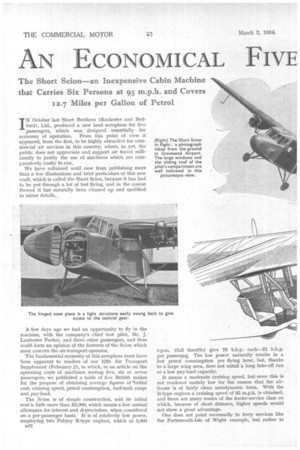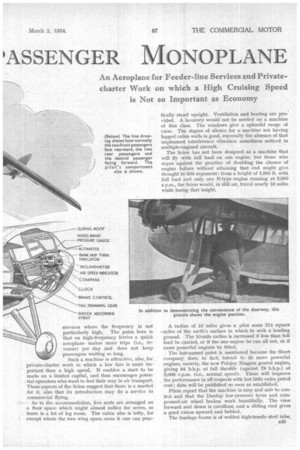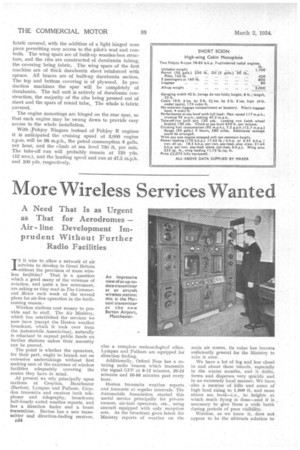AN ECONOMICAL FIVE
Page 46

Page 47

Page 48

If you've noticed an error in this article please click here to report it so we can fix it.
SSENGE
MONOPLANE
IN October last Short Brothers (Rochester and Bedford), Ltd., produced a new land aeroplane for five passengers, which was designed essentially for economy of operation. From this point of view it appeared, from the first, to be highly attractive for commercial air services in this country, where, as yet, the public does not appreciate and support air travel sufficiently to justify the use of machines which are comparatively costly to run.
We have refrained until now from publishing more than a few illustrations and brief particulars of this new craft, which is called the Short Scion, because it has had to be put through a lot of test flying, and in the course thereof it has naturally been cleaned up and modified. in minor details.
A few days ago we had an opportunity to fly in the machine, with the company's chief test pilot, Mr. J. Lankester Parker, and three other passengers, and thus could form an opinion of the features of the Scion which most concern the air-transport operator.
The fundamental economy of this aeroplane must have been apparent to readers of our 12th Air Transport Supplement (February 2), in which, in an article on the operating costs of machines seating five, six or seven passengers, we published a table of five British makes for the purpose of obtaining average figures of 'Initial cost, cruising speed, petrol consumption, fuel-tank range and pay-load.
The Scion is of simple construction, and its initial cost is little more than £2,000, which means a low annual allowance for interest and depreciation, when considered on a per-passenger basis. It is of relatively low power, employing two Pobjoy R-type engines, which at 3,000 B32 r.p.m. (full throttle) give 78 b.h.p. each-31 b.h.p. per passengei. The low power naturally results in a low petrol consumption per flying hour, but, thanks to a large wing area, does not entail a long take-off run or a low pay-load capacity.
It means a moderate cruising speed, but even this is not rendered unduly low for the reason that the airframe is of fairly clean aerodynamic form. With the R-type engines a cruising speed of 95 m.p.h. is obtained, and there are many routes of the feeder-service class on which, because of short distance, higher speeds would not show a great advantage.
One does not point necessarily to ferry services like the Portsmouth-Isle of Wight example, but rather to services where the frequency is not particularly high. The point here is that on high-frequency ferries a quick aeroplane makes more trips (i.e., revenue) per day and does not keep passengers waiting so long.
Such a machine is attractive, also, for private-charter work in which a low fare is more important than a high speed. It enables a start to be made on a limited capital, and thus encourages potential operators who want to feel their way in air transport. These aspects of the Scion suggest that there is a market for it, also that its introduction may do a service to commercial flying.
As to the accommodation, five seats are arranged on a floor space which might almost suffice for seven, so there is a lot of leg room. The cabin also is lofty, for except where the two wing spars cross it one can prac tically stand upright. Ventilation and heating are provided. A lavatory would not be needed on a machine of this class. The windows give a splendid range of view. The degree of silence for a machine not having lagged cabin walls is good, especially the absence of that unpleasant interference vibration sometimes noticed in multiple-engined aircraft.
The Scion has not been designed as a machine that will fly with full load on one engine, but those who argue agaiinst the practice of doubling the chance of engine failure without attaining that end might give thought tO this argument : from a height of 1,000 ft. with full load and only one ll-type engine running at 3,000 r.p.m., the Scion would, in still air, travel nearly 10 miles while losing that height.
A radius of 10 miles gives a pilot some 314 square -,miles of he earth's surface in which to seek a landing ground. The 10-mile radius is increased if less than full load be carried, or if the one engine be run all out, or if more powerful engines be fitted.
The last-named point is mentioned because the Short company, does, in fact, intend to fit more powerful engines, namely, the new Pobjoy Niagara geared engine, giving 84 b.h.p. at full throttle (against 78 b.h.p.) at 3,000 r.p.m. (i.e., normal speed). These will improve the performance in all respects with but little extra petrol cost ; data will be published so soon as established.
Pilots report that the machine is easy and safe to control and that the Dunlop low-pressure tyres and compressed-air wheel brakes work beautifully. The view forward and down is excellent, and a sliding roof gives a good vision upward and behind.
The fuselage frame is of welded high-tensile steel tube, B33 fabric covered, with the addition of a light hinged nose piece permitting easy access to the pilot's seat and controls. The wing spars are of built-up wooden-box structure, and the ribs are constructed of duralumin tubing, the covering being fabric. The wing spars .of the first machine are of thick duralumin sheet reinforced with spruce. All braces are of built-up duralumin section. The top and bottom covering is of plywood. In production machines the spar will be completely of duralumin. The tail unit is entirely of duralumin construction, the majority of the ribs being pressed out of sheet and the spars of round tube.. The whole is fabric covered.
The engine mountings are hinged on the rear spar, so that each engine may be swung down to provide easy access to the whole installation.
With ..Pobjoy Niagara instead of Pobjoy R engines it is anticipated the cruising speed at 3,000 engine r.p.m. will be 98 m.p.h., the petrol consumption 8 galls. Der hour, and the climb at sea level 730 ft. per min. The take-off run will probably remain at 120 yds. (12 secs.), and the landing speed and run at 47.5 m.p.h. and 100 yds. respectively.




























































































